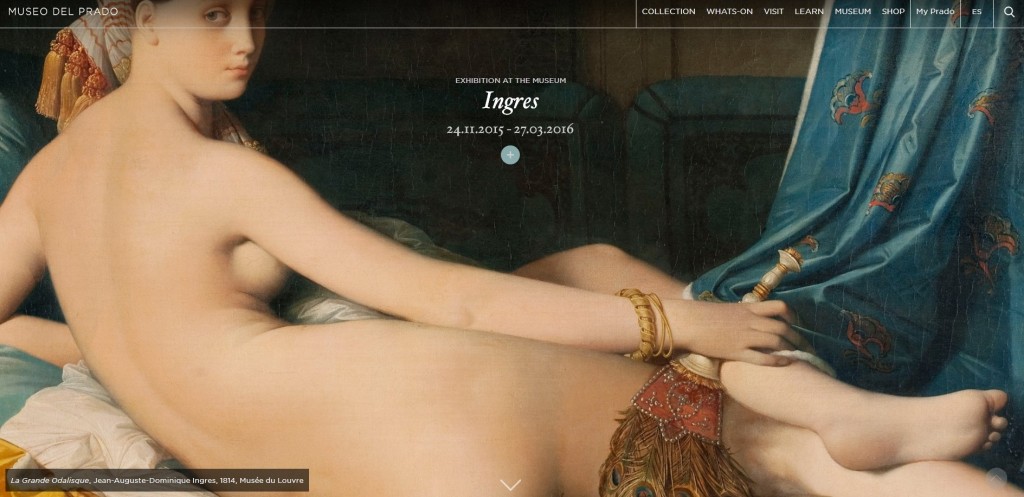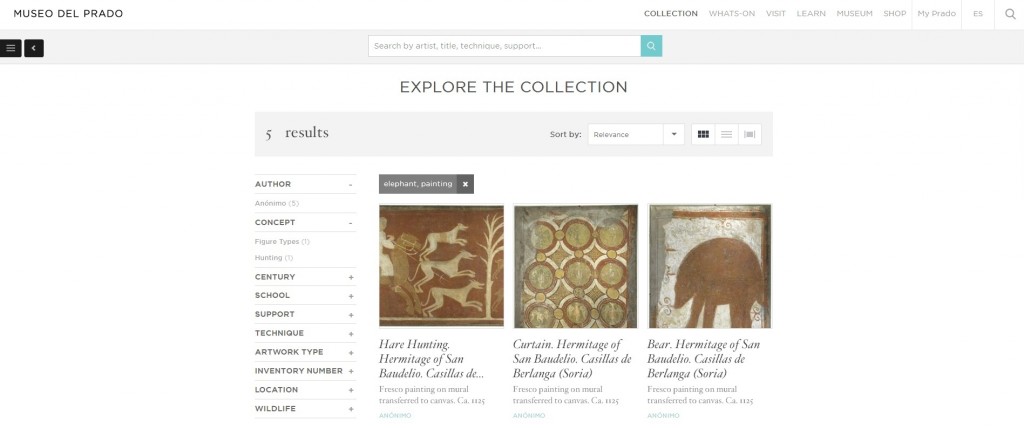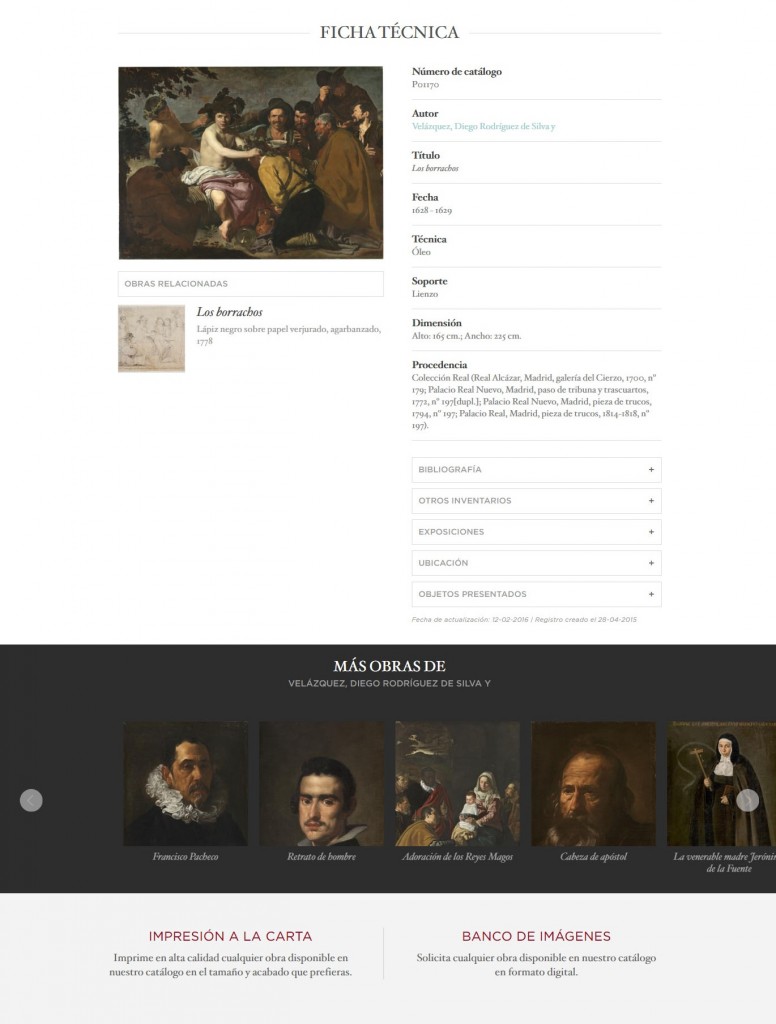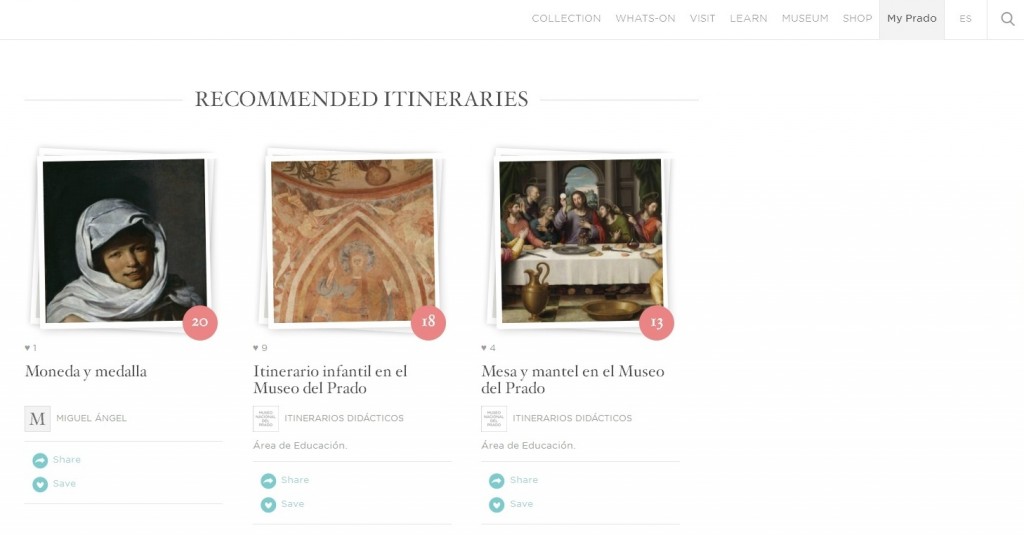Conxa Rodà
The new website of the Museo del Prado is an excellent example of how to connect the collection, the knowledge and the public. The network of interrelations between artworks’ records, the images, videos, talks, biographies, history, etc., offer very enriched and contextualised approaches of the works, the artists and the periods. All in all, this is a semantic web that takes advantage in an intelligent way of all the capital of data of the museum in an integrated way. This has been achieved by means of an intense internal work of refining and improving the data and through a complex system of data architecture.
Some figures:
- 10,000 works
- 1,800 authors
- 20,000 items of documentary archive (talks, activities, exhibitions, etc.)
- 2,8 million connections
The website was presented in December. We were lucky enough to coincide in the seminar Digital tools for the visit to the museum, with one of its main creators, Javier Pantoja, Head of Digital Development of the Museo del Prado. Javier very kindly accepted to be interviewed for our blog.
Interview with Javier Pantoja_Prado website
A process of website renovation is not exempt from difficulties. In your case, moreover, the ambition to build a semantic web will have complicated it even further. Can you explain a little the internal process that you have followed for this major project?
In 2013, the Museo Nacional del Prado published its Action Plan 2013-2016, which defines the general strategy of the museum. The plan, approved by the Royal Board of Trustees as proposed by the director, contains 5 programmes of action. The fifth is Prado online, which defines the digital strategy within the museum general strategy.
The carrying out of three fundamental actions was considered necessary:
- Prado Website
- Prado Mobile
- Prado Redes Sociales
Prado Website has deserved greater attention given that the website launched in 2007 was considered to have come to an end of its useful life and had been suitably amortized. The strategic aim: to increase the access, use, diffusion and knowledge of the Collection of the Museo Nacional del Prado and its related content, as well as its general activity through the website.
Was it hard to get the involvement and the coordination of the work of the various departments, each with its priorities and specific rhythms?
The coordination of this project was in the hands of the Web and Online Communication Service which in that moment depended on the Area of Communication which in itself depended on the Management of the museum. At an internal level this implied the coordination between the different departments serving as the link between those most focused on technological issues, and those working on the content. At an external level, the hiring and direct relation with the necessary professionals and companies for carrying out the project (development of the back end and front end, servers, designs, UX (User Experience), definition of the concept, etc. And finally, to serve as the link between these companies and the different departments of the museum involved in the project.
Three phases of the project were established which worked in a parallel way and were interrelated:
- the updating and adaptation of the Integrated Digital Asset Management coordinated by the Documentation Service and the IT Service with the coordination of the Web Service as the basis of the project
- the analysis of the UX (User Experience), the key ideas, the design concept, the structuring of the content and the prototyping, as well as the browsing and usability study to end with the layout of the Front End carried out by a design team and external UX along with the Web Service
- the semantization of the documentary database, the website of structured data, and semantic CMS (Content Management System) carried out by an external company. This last process culminated with the presentation of the Knowledge Graph of the Museo del Prado.
Dedicating 3 years to treating, improving and completing the data is very meritorious. It is not always understood that investing time in the quality of the data is crucial for a robust and useful website! Can you explain a little about the work of the documentalists for the website?
In the last 10 years of the Museo del Prado, by means of the Documentation Service and the IT Service, work has been carried out on the setting in motion of an integrated system of documentary management (SIGMA) based on the existing databases in the different departments that work with the collection (Conservation, Registry, Restoration, Photographic Archive, Exhibitions, etc.)
The main idea of all this process was not only to link the databases between themselves, but also to achieve the fact that all the processes of internal work of the museum could be transformed into relevant information about the works.
With an eye already fixed on the new website, the work during these last three years has been to turn this system of documentary management into the basis for the new website
- to synchronize its databases with the content management system
- to analyse the information it contains as a possible generator of related content and contexts
- to turn these databases into a semantic graph that generates knowledge and that can be examined by the users.
The work of the documentalists is essential in the current website given the fact that their work continues to be the computerised management of the documentation generated by the Museo del Prado about its works, but the same could be said, for example, of the Photographic Archive or of other departments that produce or collect information. With the new website this information doesn’t only generate internal knowledge or knowledge for researchers, but it is also accessible for all the website users thanks to the synchronization between the databases and the semantic system of content management.
This is a website very much focused on enabling the browsing and usability. Did you involve the public in the process? Was any testing carried out with the users? (card sorting, eye-tracking, focus groups, etc.)
We began the project with a phase of comprehension and definition, applying certain tools of analysis within the reach of the professionals of UX (User Experience). The first technique was the ethnographical analysis, with the aim of studying the behaviour of the visitors within the museum, while trying to not interfere with their actions, uses and habits. Beyond this passive observation, we carried out direct mini-surveys to certain types of visitors. This technique, added to others of data gathering, helped us to get to know better the physical visitor. However, it was the digital user of the Prado about whom we needed to know the needs, expectations and barriers. And to do so, we used another UX technique created by Alan Cooper, the creation of personas.
The Design/UX team along with the team charged with the development of the project in the museum, defined up to 15 files/profiles of archetypes of people –from a Secondary Education Teacher, to a family of European tourists, to a housewife or a North American art student; recreating detailed personalities at a level of user profile, so as to be able to focus more on the target of the website and to help us in the decision-making regarding the design, structuring of content, browsability, concept, etc.
The users can create their own itineraries and share. The section “My Prado” allows them to personalise the content. But I believe that there isn’t any space on the website for collaborative participation, to include content generated by the users. Is this foreseen in the future?
During the analysis phase, we saw that the users carried out a very active participation on social media and we decided to include this participation in the website itself. The conversation generated on social media – mainly Twitter and Facebook- is considered as part of the news of the museum at the same level as an activity, an educational programme, the publication of a video about a talk or an exhibition, etc. From the social networks we have managed to get a flow of very interesting information and an important feedback. For example, we have gone as far as modifying the signs in a room thanks to the contribution of our followers, for not talking about content from the website itself.
Furthermore, My Prado aims to be a channel in which it is the user who conditions its use based on a simple functionality: the creation of online itineraries about the favourite works. This opens up a field of opportunities depending on the profile of the users: educational, visit, research.
Were some content or some functionality planned at the outset but then discarded on the way? What would you say has remained pending for another phase?
We are now at the stage of sitting down and analysing what we launched a couple of months ago. After this phase of analysis in which we will be evaluating and assessing the response of the users, we will start a new period in which we will evolve the project according to this response and the interests of the museum.
At an institutional level we believe that in carrying out this project we have fulfilled the demands that we imposed on ourselves from the Action Plan, and therefore, from the digital strategy. At a personal level or from the team involved in the project, it is logical to think that there will always remain the doubt of whether we should have done more, if it would have been possible, how we would have done it, etc.
There’s still a lot pending:
- to continue extending the works that are exhibited in the galleries
- to continue enlarging and updating the information about the works
- to generate better contexts in the website itself for the information that users are looking for
- to define with more specificity the graph of knowledge of the museum, etc.
Any frustrations? Are there any mistakes that if you had to start all over again you wouldn’t commit?
All that you can imagine and none specifically! A project like this, and not wanting to magnify it, is a very intense professional experience that gets close to being a vital experience for all of those who were directly involved in it. Doubts emerge, as well as tensions and frustrations, on a daily basis which have to be overcome so that the project can be carried out.
What would you recommend to other museums, small and medium-sized, that are without the human, technological and economic resources of a major museum, that want to begin their journey in Linked Data?
I don’t know if it corresponds to me to make recommendations to other museums, in which their work is being carried out, not always in optimum conditions, colleagues for whom I have an enormous respect.
Focusing a museum towards digital is not only a question of attitude, but also of means. I would say that, as a first step, the most relevant thing is the digitisation and computerised documentation of their assets as a Museum, making it possible for digital to be part of the general strategy of the museum. And, finally, to search for internal and external alliances, in this case in the linked data, for carrying out a work that if it doesn’t have to be or can’t be complete, it can however be incipient.
Future projects in digital in el Prado
As I said before, we are now in a phase of analysis of what has been carried out. Evidently we know where we want to go but we prefer to contrast it with the users to see if what we think it means is really what they want. On the other hand, we will try to take an in-depth look at the possibilities offered to us by the fact of having a semantic web of structured data, a semantic graph, etc., and the possible exploitations of this technology that, a priori, are many and not all exclusive to a website setting.
Thank you very much, Javier!
You have built a great website, which invites you to dive in its multiple layers of browsing. We enthusiastically congratulate the colleagues at the Prado for their hard work. A very significant step in Linked Data, towards where museums start to be heading.
This web project has been selected to be presented in the next Museums and the Web Conference, in which our museum has the honour of forming part of the program committee and of the jury of its Best of the Web Awards.
Recommended links:
Presentation of the new website (video, 1h5min – In Spanish)
GNOSS company, developer of the Museo del Prado website
Co-directora del Curs d'Estratègia Digital_UOC_Museu Nacional d'Art de Catalunya
Co-directora del congrés CIMED de Museos y Estrategias Digitales













